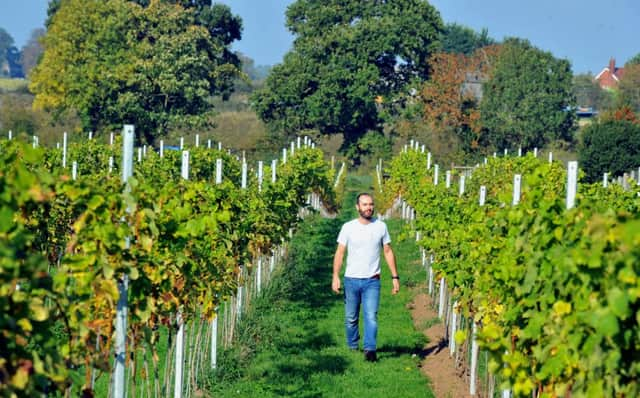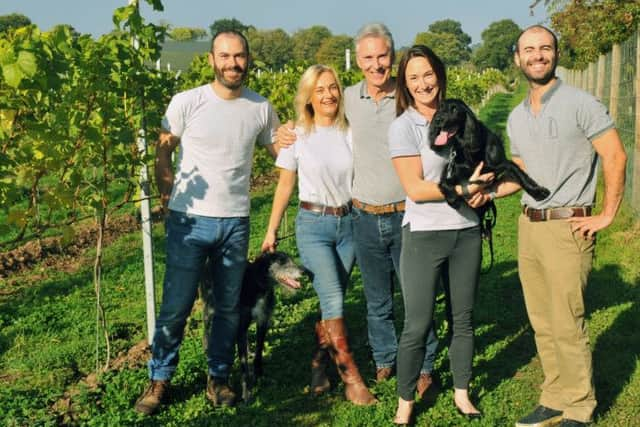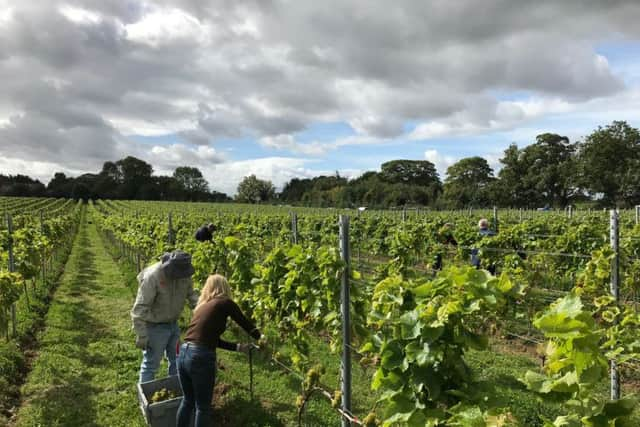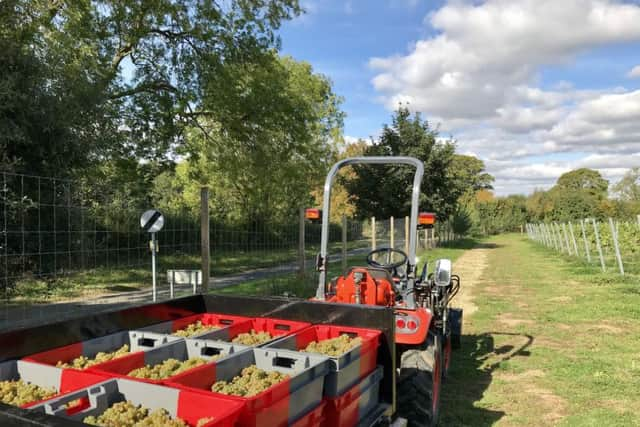Welcome to the Yorkshire vineyard that's a little piece of Italy


Dunesforde Vineyard is Yorkshire newest vineyard, planted two years ago by James Townsend with no little support from the rest of his family, as well as virtually the entire village of Upper Dunsforth – well there are only 22 houses.
This year the vineyard saw its first harvest which early next year will see James taste the fruits of his labour of love for the first time.
Advertisement
Hide AdAdvertisement
Hide Ad“We aim to have 1,500 bottles early next year building up to our capacity which will eventually be around 10,000 bottles in about eight to ten years time,” he says.


“The wine should be ready to taste in January or February which is very exciting, although we have tasted the grapes as we have gone along.”
What makes this northern vineyard even more unusual is that it is pretty much in the garden of the Townsend family home, where his parents have lived for more than 30 years and from where father Ian runs the family’s investment business, along with James’s brother Peter and sister Georgina and mum Mandy.
But James had never planned to create a vineyard so close to this home, in fact he had never really planned to make English wine at all.
Advertisement
Hide AdAdvertisement
Hide AdIronically it wasn’t until he worked in a vineyard that he actually even started to like drinking wine – he loves it now, he assures me.


The former teacher had been finishing his degree, which involved a spell in Italy – he speaks the language fluently – when he spent some weeks volunteering on a vineyard in Tuscany.
“I went for two weeks and ended up staying for three months. I just loved the way something came from the earth and also the way the local community got involved and I realised that it was something that I really want to be involved in.”
On his return to the UK he embarked on a wine course and soon realised that he wanted to make his own wine.
Advertisement
Hide AdAdvertisement
Hide AdInitially he planned to create a vineyard in Tuscany. But as he and his dad toured the region looking for potential sites it soon became clear that the area was literally saturated with vineyards.


“So we started to look for something closer to home,” says James.
“The reputation of English wine had really started to change and there are some great wines around which have become household names and so we moved our search to the south of England.”
But again the Townsends failed to find a suitable site. “It took longer to get to the south of England than it did to fly from Leeds Bradford to Italy,” says Townsend senior. “And there were already a number of well established vineyards down there.”
Advertisement
Hide AdAdvertisement
Hide AdAnd so they moved their search closer to home. When five acres of agricultural land adjacent to their home in Upper Dunsforth came up for sale they enlisted experts to check out the viability of the land for viticulture. “We were actually quite surprised by how positive they were,” says James.
“The land is on a slight slope and, bizarrely, the climate isn’t that different from Tuscany. The soil was perfect for growing grapes and it is relatively sheltered with low rainfall during the vital growing season.”
Like any other northern vineyard, there is always the danger of frost, but the Townsends once again did their research.
“They make ice wine from frozen grapes on the vine and there is a farmer in Scotland who has started his own vineyard. There are a number successful Yorkshire vineyards and we visited some of them before we decided to buy the land.”
Advertisement
Hide AdAdvertisement
Hide AdAfter purchasing the land, they bought 6,100 vines from Germany, again with advice from the experts as to what grape varieties were best suited to their northern location.
“With the benefit of expert advice, we carefully chose the vine varieties and root stocks to match our soil and climate. While we are definitely on the edge of where it is possible to ripen grapes, we believe the challenging nature of our site and longer ripening will produce more complex fruit for more interesting wines. Our aim is to produce a range of outstanding cool climate wines,” says James.
Four varieties of grapes are grown at the vineyard, which the family named “Dunesforde” – the name for Upper Dunsforth in the Domesday Book. Peter is something of an etymologist and it was his suggestion to name the vineyard Dunesforde.
Bacchus, Solaris, Pinot Gris, and Pinot Noir Early are the variety of grapes which will make three white wines and one red. James also has plans for a sparkling wine and a rose variety in the future. After the first pruning which took place in during March 2017 the family installed trellising.
Advertisement
Hide AdAdvertisement
Hide Ad“The trellis system is crucial to training the vines to grow in order to achieve consistent ripening throughout the vineyard. Arranging the vine along the trellis enables us to maximise the vines’ exposure to the sun, therefore maximising the amount of sugars in the grapes. The system we’ve installed has over 1,000 posts and in excess of 36km of wires to help us organise the vines.”
Although we suffered one of the coldest and snowiest winters on record this year, with the Beast from the East pummeling the country, James’s vines came away virtually unscathed.
“The vines themselves are incredibly hardy and are dormant during the winter period,” he explained. “The problem is frost in the growing season when it will kill off any new growth, but even then the vine itself will survive it could just affect your harvest.”
The whole ethos of Dunesforde Vineyard is to get the community involved. Throughout the process so far they received support from many villagers, some of them retired, who were intrigued with what was happening in their village.
Advertisement
Hide AdAdvertisement
Hide Ad“It was great to have so many people come help with the pruning, we love sharing what we’re doing and helping others learn something new. The togetherness of working in the vineyard and sharing stories is one of the things we enjoy most about inviting people to Dunesforde.
“With all the help we received with pruning the vines, what we expected to take almost two weeks, actually took only seven days.”
All volunteer days are accompanied by lunch provided by mum Mandy. But the biggest village involvement came with the first harvest which started mid-September and ended a couple of weeks ago. “We couldn’t believe how many people came along and wanted to help,” says Townsend senior. “I think they are really excited about having a vineyard in the village and feel a type of ownership.”
They don’t have the facilities to press the grapes and make the wine in Upper Dunsforth, although that could be a plan for the future.
Advertisement
Hide AdAdvertisement
Hide AdAt the moment the grapes are being turned into wine at Halfpenny Green Wine Estate in the Midlands and so the Townsends are now in the process of looking at their branding and marketing for their wine, a difficult task when you haven’t even tasted it. “We’re getting advice from a brand agency about the look of the bottles and the labels but it is quite a challenge when you haven’t actually got a product yet.It is all a bit of a learning curve.”
They are aiming at quite a high end market and are cheered by the fact the likes of Michelin-starred chef Tommy Banks has an English wine on his wine list.“It just shows how far English wine has come and we aim to be a part of that.”
www.dunesforde.com.